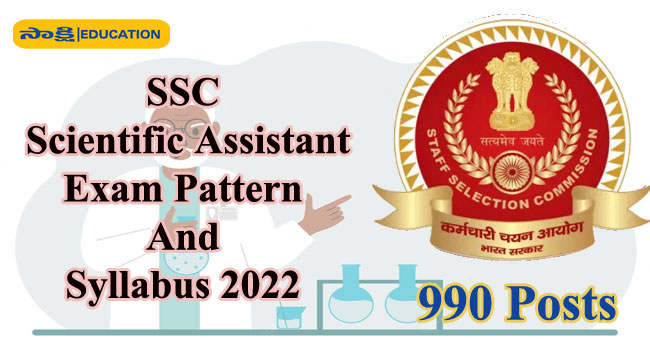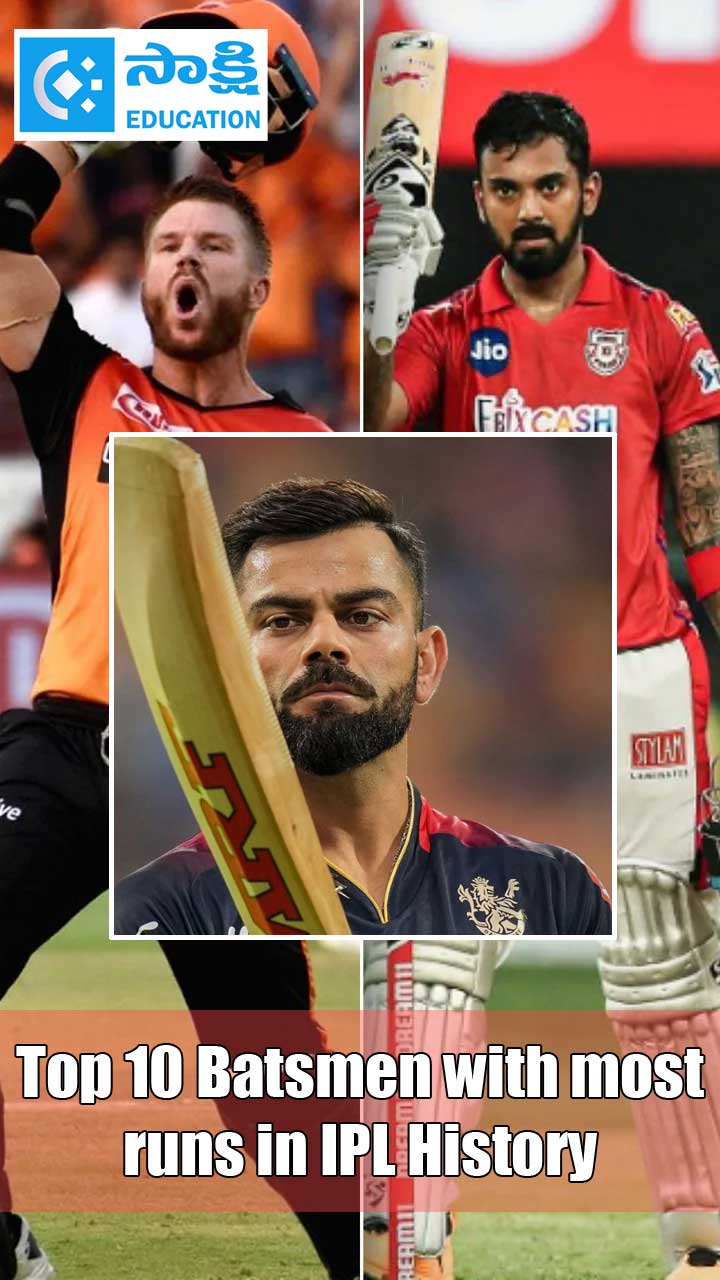SSC Scientific Assistant Examination Pattern & Syllabus 2022

SSC Scientific Assistant - Scheme of the Examination:
The Commission will conduct a Computer Based Examination comprising 200 questions carrying 200 marks for two hours duration.
The question paper would have two parts, Part-I and Part-II as detailed below:
|
Papers |
Subject |
No. of Questions |
Duration |
|
Part-I Computer based Examination |
(i) General Intelligence & Reasoning |
25 |
120 Minutes |
|
(ii) Quantitative Aptitude |
25 |
||
|
(iii) English language & Comprehension |
25 |
||
|
(iv) General Awareness |
25 |
||
|
Part-II Computer based Examination |
Physics / Computer Science & Information Technology / Electronics & Telecommunication Engineering |
100 |
The candidates will be required to attempt both Part-I and Part-II of the examination. Part-II of examination will be on the basis of subject opted in the online application form.
Note:There will be negative marking of 0.25 marks for each wrong answer in the examination. Candidates are, therefore, advised to keep this in mind while answering the questions.
SSC Scientific Assistant Part I Syllabus
General Intelligence & Reasoning: The Syllabus for General Intelligence would include questions of both verbal and non-verbal type. The test may include questions on analogies, similarities, differences, space visualization, problem solving, analysis, judgement, decision making, visual memory, discrimination, observation, relationship concepts, arithmetical reasoning, verbal and figure classification, arithmetical number series etc. The test will also include questions designed to test the candidate’s abilities to deal with abstract ideas and symbols and their relationships, arithmetical computations and other analytical functions.
General Awareness: General, physical, geographical, topographical, economic and climatic features of India. Current events. Matters of everyday observation and experience on scientific aspects and reasoning. Basic topics of Mathematics, Chemistry and Physics. History of India, its cultural heritage, freedom movement, salient feature of the Constitution of India. Economic and social aspect of the country and its people
Quantitative Aptitude: The questions will be designed to test the ability of appropriate use of numbers and number sense of the candidate. The scope of the test will be computation of whole numbers, decimals, fractions and relationships between numbers, Percentage, Ratio & Proportion, Square roots, Averages, interest, Profit and Loss, Discount, Partnership Business, Mixture and Alligation, Time and Distance, Time & Work, Basic algebraic identities of School Algebra & Elementary Surds, Graphs of Linear Equations, Triangle and its various kinds of center, Congruence and similarity of triangles, Circle and its chords, tangents, angles subtended bychords of a circle, common tangents to two or more circles, Triangle, Quadrilaterals, Regular Polygons, Circle, Right Prism, Right Circular Cone, Right Circular Cylinder, Sphere, Hemispheres, Rectangular Parallelepiped, Regular Right Pyramid with triangular or square base, Trigonometric ratio, Degree and Radian Measures, Standard Identities, Complementary angle, Heights and Distances, Histogram, Frequency polygon, Bar diagram & Pie chart. English Language and Comprehension English grammar, Vocabulary, Spellings, Synonyms and Antonyms, Comprehension, Correct and incorrect usages, etc
SSC Recruitment 2022 Scientific Assistant Part IISyllabus
Physics
Mechanics: Units and dimensions, SI Units, Newton’s Laws of Motion, conservation of linear and angular momentum, projectiles, rotational motion, moment of inertia, rolling motion, Newton’s Law of gravitation, Planetary motion, Kepler’s Laws of Planetary motion, artificial satellites, Fluid motion, Bernoulli’s theorem, Surface tension, Viscosity, Elastic Constants, bending of beams, torsion of cylindrical bodies, elementary ideas of special theory of relativity.
Thermal Physics, Radiation & Sound: Equations of state, Ideal and real gases, Dalton’s law of partial pressure. Thermometry, Zeroth, first and second laws of thermodynamics, reversible and irreversible processes, Heat engines, Maxwell’s relation, Heat Capacities, Adiabatic and Isothermal processes, Clausius-Clapeyron relation, Thermal Conductivity, Thermodynamic state variables, viz., Internal energy, Entropy, Enthalpy, Helmholtz’s free energy function, Gibb’s free energy function. Vapour pressure, evaporation. Kinetic theory of gases, Brownian motion, Maxwell’s velocity distribution, Equipartition of energy, mean free path Vander walls’ equation of State, Liquefaction of gases. Blackbody radiation, Kirchhoff’s law, Stephen’s law, Planck’s law. Conduction in solids.
Wave and Oscillations: Simple harmonic motion, wave motion, superposition principle, Damped oscillations; forced oscillations and resonance; simple oscillatory systems; vibrations of rods, strings and air columns. Doppler effect; Ultrasonic; Sabine’s law of reverberation; Recording and reproduction of sound.
Optics: Nature and propagation of light; Reflection & Refraction. Interference; diffraction; polarization of light; simple interferometers. Determination of wavelength of spectral lines, Electromagnetic spectrum. Rayleigh scattering, Raman effect, Lenses and mirrors, combination of coaxial thin lenses, spherical and chromatic aberrations, and their corrections, Microscope, Telescope, Eyepieces and Photometry.
Electricity and magnetism: Electric charges, fields and potentials, Gauss’s theorem, Electrometers, Dielectrics, Magnetic properties of matter and their measurement, Elementary theory of dia, para and ferro-magnetism, Hysteresis, Electric current and their properties, Ohm’s law, Galvanometers, Whetstone’s bridge and applications, Potentiometers, Faraday’s law of E.M. induction, self and mutual inductance and their applications, alternating currents, impedance and resonance, LCR circuit, Dynamos, motors, transformers, Peltier Seebeck and Thomson effects and applications, electrolysis, Hall effect, Hertz experiment and electro-magnetic waves, Particle accelerators and cyclotron.
Atomic structure: Electron, measurement of ‘e’ and ‘e/m’, measurement of Planck Constant, Rutherford-Bohr Atom, X-rays, Bragg’s law, Moseley’s law, Radioactivity, Alpha-Beta-Gamma emission, Elementary ideas of nuclear structures, Fission, Fusion and Reactors, Louis de Broglie waves and Electron Microscope.
Electronics: Thermo-ionic emission, diodes and triodes, p-n diodes and transistors, simple rectifier, amplifier and oscillator circuits.
Calculus: Limits, Differential calculus (Differentiation), Integral calculus (Integration), Multivariable calculus (Function theory), basic concepts of differential equation, viz., types, order, degree of differential equations. Concept of Laplacian of a function.
Linear algebra: Concept of a Vector Space, Basic concepts of linearly dependent/ independent vectors. Matrix and determinant. Concepts of Eigen Value and Eigen Vectors.
Vector Algebra & calculus: Zero Vector, Unit Vector, Position Vector, Co-initial Vector, Like and Unlike Vectors, Co-planar Vector, Collinear Vector, Equal Vector, Displacement Vector, Negative of a Vector, Vector and Scalar Quantities, Vector Formulas, Components of a Vector, Vector Addition and its Laws, Multiplication of Vectors and Scalar Quantity, Vector Algebra, Dot Product of Two Vectors, Scalar Triple Product. Basic concepts of Vector calculus, viz., Grads, Divergence, Curl, Stokes theorem, Gauss divergence theorem
Computer Science and Information Technology
Computer: History of Computers and their classification, Basic Organization, Memory–RAM, ROM, EPROM, etc., Magnetic-Floppy, Hard disks, CDROM, WORM etc., Concept of Virtual Memory and Cache Memory, Number systems, binary, octal, Hexadecimal, Binary Addition, Subtraction and Multiplication, Flotation, point representation and arithmetic, Arithmetic through stacks.
Operating systems: assemblers, elements of Assembly language programming-Overview of the Assembly process, assembler for the PC, Process synchronization, Memory Management – address Binding– dynamic Loading and linking – overlays – logical and Physical address space – Contiguous Allocation – internal & External Fragmentation. Non-Contiguous Allocation: Paging and Segmentation Schemes – Implementation – Hardware Protection – Protection –sharing – Fragmentation.
Virtual Memory: Demand Paging – Page Replacement – Page Replacement algorithms – Thrashing.
File System: File Concepts – Assess Methods – Directory Structures –Protection Consistency Semantics – File system Structures – Allocation Methods – Free Space Management.
I/O System: Overview – I/O hardware – Application I/O Interface – Kernel I/O subsystem, Performance, Secondary Storage Structures, Protection, Goals, Domain – Access matrix.
Assemblers: Elements of assembly language programming – Overview of the Assembly process – Design of a low-pass Assembler – a single pass Assembler for the PC. The security Problem – Authentication – Threats – Threat Monitoring – Encryption.
Fundamentals of programming: Unix Programming, Programming in FORTRAN, C, Object Oriented Programming in C++, programming in Java, Basics of compilers.
Database Management Systems: Advantages and components of a Database Management Systems, Data Types, Data Dictionary, Query Basics, Forms and Reports, Graphical objects, Error Handing, Distributing Application, Data Storage Methods, Data Clustering and Partitioning, Database Administration, Backup and Recovery, Security and Privacy, Distributed Databases, Client/Server Databases, Object Oriented Databases, Integrated Applications, SQL, RDBMS.
Internet Technology: Basics, topologies, layers, switching in the networks, bridges, routers and gateways, types of networks, WWW. Client/Server Applications, Internet Standards and specifications, ISP, Broad Band Technologies, Protocols, web-servers, browsers, and security, fire walls, data security, HTML, dHTML, XML, Web designing.
Fundamentals of Geographical Information System (GIS): GIS Data and Spatial Models, Topology and Spatial Operations, Projections, Scale and Coordinate Systems, Mapping, GIS Analysis, Cartography. Basics of GIS application development.
Electronics & Telecommunication
Electronics: Conductors, Semi-conductors, Insulators, Magnetic, Passive components, characteristics of Resistors, Capacitors and inductors.PN Junction diode, forward and reverse bias characteristics and equivalent circuits of diode, Zener diode and applications, clipping, clamping and rectifier circuits using diodes.
Bipolar Junction Transistors (BJT), Field Effect Transistor (FET) and MOSFET; Biasing and stability, Emitter follower and its applications – Negatives Feedback-Transistor as a switch, Multistage Amplifiers, Feedback, Oscillators, Multi vibrators, Voltage regulation, Power amplifiers.
Introduction to Network Theorems: Kirchoff’s laws, superposition, Thevenin’s , Norton’s and Maximum power theorems. Voltage and Current relationship in the resistance, inductance and capacitance. Concept of reactance, susceptance, conductance, impedance and admittance in series and parallel RL, RC and RLC circuits – Three phase supply-star and delta connection diagrams – Relation between line and phase & voltages and currents, series and parallel resonance circuits – condition of resonance, resonant frequency, Q factor and bandwidth.
Digital electronics:–Logic gates, Demorgan’s theorem, Boolean algebra, frequency counters, flip-flops, shift resistors, Basic concepts of Digital to Analog and Analog to Digital Converters, Timing circuits, Digital logic circuits, systems & codes Combinational logic design.
Telecommunication: Basic antenna principle directive gain, directivity, radiation pattern, broad-side and end-fire array, Yagi antenna, Parabolic antenna, Ground wave propagation, space waves, ionosphere propagation and electromagnetic frequency spectrum, Modulation, types of modulation, Amplitude Modulation (AM), Modulation index, Power relation in AM, Generation and Demodulation of AM.
Single Side Band (SSB): Power requirement in comparison with AM, Advantages of SSB over AM. Concept of Balanced Modulator, Generation of SSB, Pilot Carrier System. Independent Side System, Vestigial Sideband Transmission.
Frequency Modulation (FM): Definition of FM, Bandwidth, Noise triangle, Pre-emphasis and De-emphasis.
Pulse Modulation (PM): Definition of PM. Difference between AM and FM. Radio receivers. Sampling Theorem, PAM, PTM, PWM, PPM, pulse code modulation, Quantization noise, commanding, PCM system, differential PCM, Delta modulation.
Multiplexing: FDM/ TDM. Introduction of digital Communication: PSK, ASK, FSK, introduction to fiber optics system, Propagation of light in optical fiber and ray model Propagation of signals at HF, VHF, UHF and microwave frequency and satellite communications
SSC Recruitment 2022 Scientific Assistant - Important Dates
- Last date and time for receipt of online applications: October 18, 2022 (23:00)
- Last date and time for generation of offline Challan: October 19, 2022 (23:00)
- Last date and time for making online fee payment: October 20, 2022 (23:00)
- Last date for payment through Challan (during working hours of Bank): October 20, 2022
- Date of ‘Window for Application Form Correction’ including online payment: October 25, 2022 (upto 23:00)
SSC Scientific Assistant Notification 2022: Click Here
















